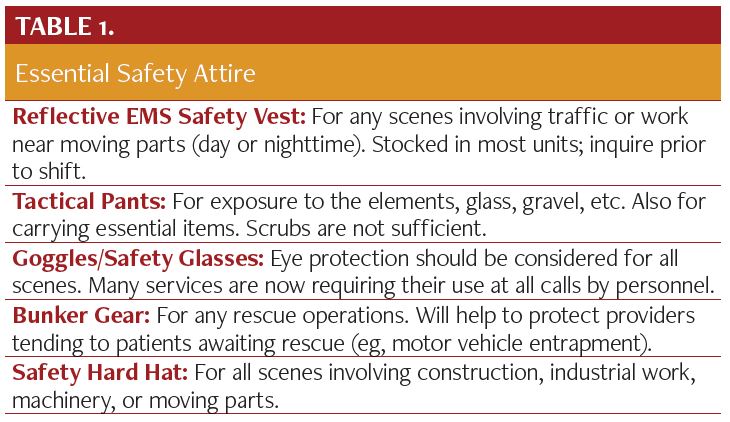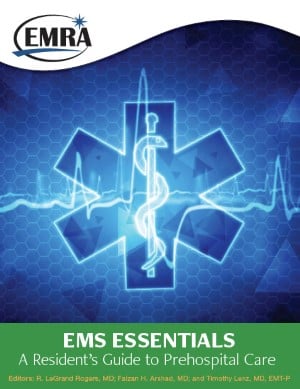Ch 3. Safety
Safety is a process requiring awareness, experience, and con- tinuous reassessment. It is the primary concern for medical stu- dents and residents on EMS rotations. This section will explore common scenes encountered by first responders and will offer guiding principles to ensure provider safety; however, this is by no means conclusive or all-encompassing. The most import- ant principle is to not enter a situation where your safety may be compromised. Your No. 1 priority at all times is looking after your own safety! (Table 1)

Emergency Vehicle Operations
Operating an emergency vehicle is the highest-risk task EMS providers undertake. Should you find yourself operating these vehicles (only after formal training and authorization; very few EM residency programs allow this), follow these general guide- lines:
- Emergency response vehicles are requesting the right of way; expect other drivers to deny that request or not understand it.
- More noise is better noise! Utilize the many sound settings on your vehicle to broadcast your intentions.
- For all opposing signals (red lights, stop signs, yield zones), make a full stop and eye contact with other drivers to ensure they see you and understand your intentions. Do not proceed if you are not confident other drivers understand you are responding to an emergency and are requesting the right of way.
- When you arrive on scene, reduce your noise level, but keep lights on even after you leave your vehicle.

Sizing up the Scene
Make it a habit, no matter the call, to take a few seconds for critical scene assessment. This will also help determine what equipment to take when you do leave the safety of your vehicle.
- Scene Approach: Look for obvious hazards first; any mention of hazards on dispatch call?
- Potential Assault or Harm: Is law enforcement on scene? If there is any doubt about safety, call for law enforcement to secure the scene prior to your entry! Do not enter the scene without an all-clear from law enforcement personnel.
- Required Equipment: Flashlight, traffic or safety vest, helmet or head protection, safety glasses, and personal protective equipment for infection control.
- Requesting Additional Resources: Use radio to describe the scene (eg, number of potential patients, entrapment, mechanisms of injury, location, and other potential hazards).
- Questionable Safety: Retreat immediately to a predetermined staging area while awaiting law enforcement. Open public areas like parking lots one or two blocks away on a main road allow for quick entrance and exit to main roads, with good scene visualization.
The Motor Vehicle Collision (MVC)
This is one of the most frequent calls EMS responds to, and it entails significant risks to providers. These scenes should not be entered without appropriate traffic control and support from other units.
- Evaluate the scene and determine required resources; do not enter traffic without other units providing traffic control.
- Watch especially for downed wires, which may be energized.
- Always wear a bright, reflective traffic vest.
- Unstable vehicles: If there a vehicle is unstable, especially in cases of required extrication or any question of fire/ combustion safety, wait for fire and rescue assistance.
- Vehicles can be hot: any exposed body area can be burned.
- Wear appropriate fire safe materials before working with any potential for exposed engine components.
- Ongoing /prolonged extrication or rescue work: establish ABCs, reassure patient, communicate rescue progress, consider pain management options, and begin initial medical care when possible.

Fire, Water Emergencies, and Other Rescue Operations
The type of scene may vary significantly, but the ultimate ob- jective is the same: making sure that providers (and patients!) go home safely at the end of the day.
- Do Not Enter a Fire Scene: The fire professionals will handle fire. Wait for patients at designated medical treatment areas. These areas may require your supervision as a physician. Review National Incident Management System (NIMS) mass casualty protocols.
- Water Emergencies: DO NOT attempt a water rescue without specific training. Wait for patients at designated areas.
- Ensure Safety of Medical Treatment Area: Winds may change, and your location will require periodic reassessment. Consider smoke and hazardous materials flow, and continuously reassess.
- Scene-specific Provider Health Hazards: Smoke inhalation, CO poisoning, burns, and hypo/hyperthermia are all risks. Evaluate providers with full exam, and watch for those who need further ED evaluation. Solicit assistance from other fire personnel as needed. Providing simple scene support such as water and cool-down areas can have a significant effect for other responders.
- Team Dynamic: Coordinate with incident commanders to find where your talents will be best utilized. ALWAYS check in with a scene commander when you arrive and before you enter any potentially hazardous areas.
Residential/Domestic Scenes
In a metropolitan or suburban area, a common scene for EMS is in the domestic residence. Whatever the location, the basic principles of safety must be considered.
- Reduce Risk Before Entering Scene: Hazardous scenes warrant law enforcement involvement. These include assault, use of deadly force (guns, knives, blunt trauma, etc.), domestic violence, psychiatric emergency, drug overdoses, or any high-risk scenarios.
- Approaching Domestic Residence: Knock and announce your presence. Stand to the side of doors when waiting for response.
- Entering Enclosed Areas (apartment, living room, etc.): Scan for safety, keep eyes on exits, know where you are at all times. Avoid going anywhere alone or without support.
- Altered Mental Status: Consider safety aspects involving altered/combative patients/citizens, nature of illness (stimulant overdose, hallucinogen, etc.). Be prepared to use an exit strategy or law enforcement support.
- Dangerous Situations: Use an appropriate amount of force to protect yourself/others; metal clipboards, flashlights, and even O2 cylinders can be used to deter assaults. Exit immediately and call for assistance. Inquire about radio emergency code words prior to your shift. Do not retrieve equipment! No amount of equipment is worth a provider’s safety.





